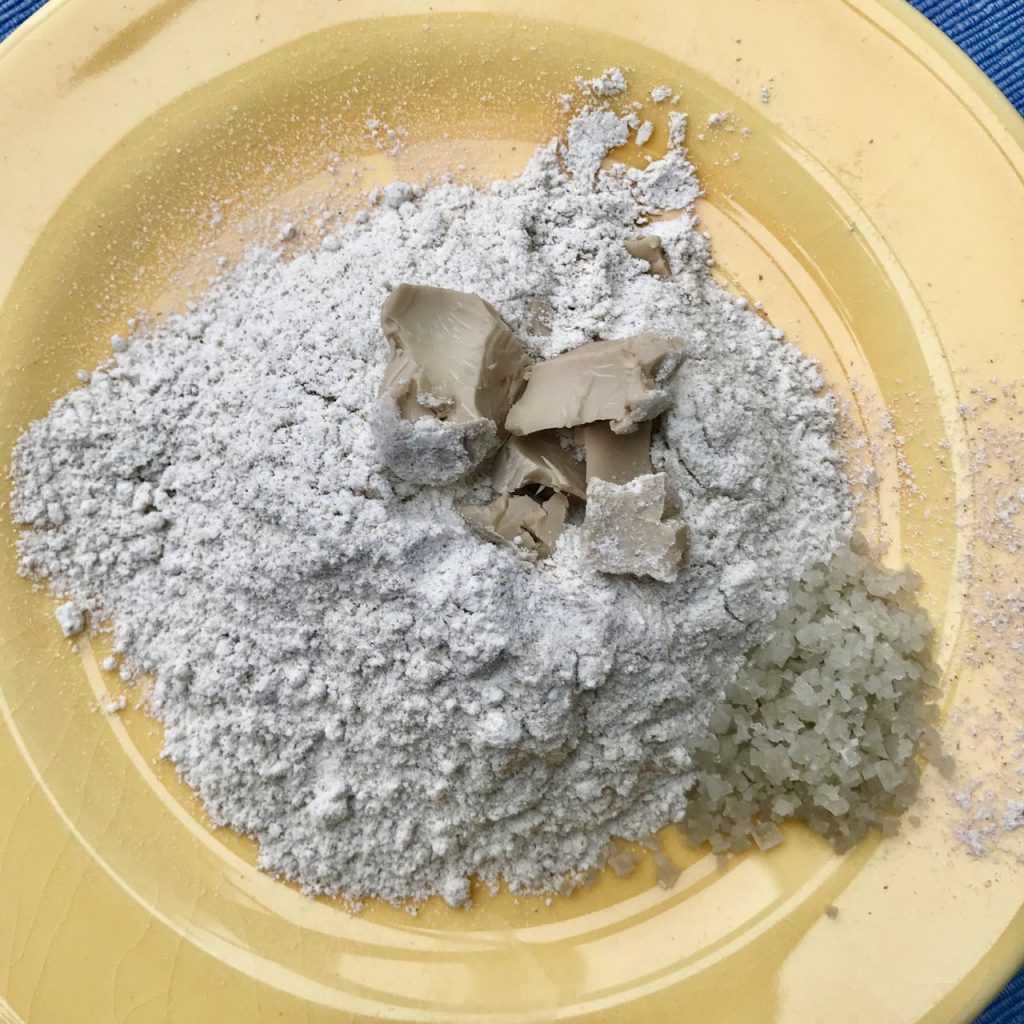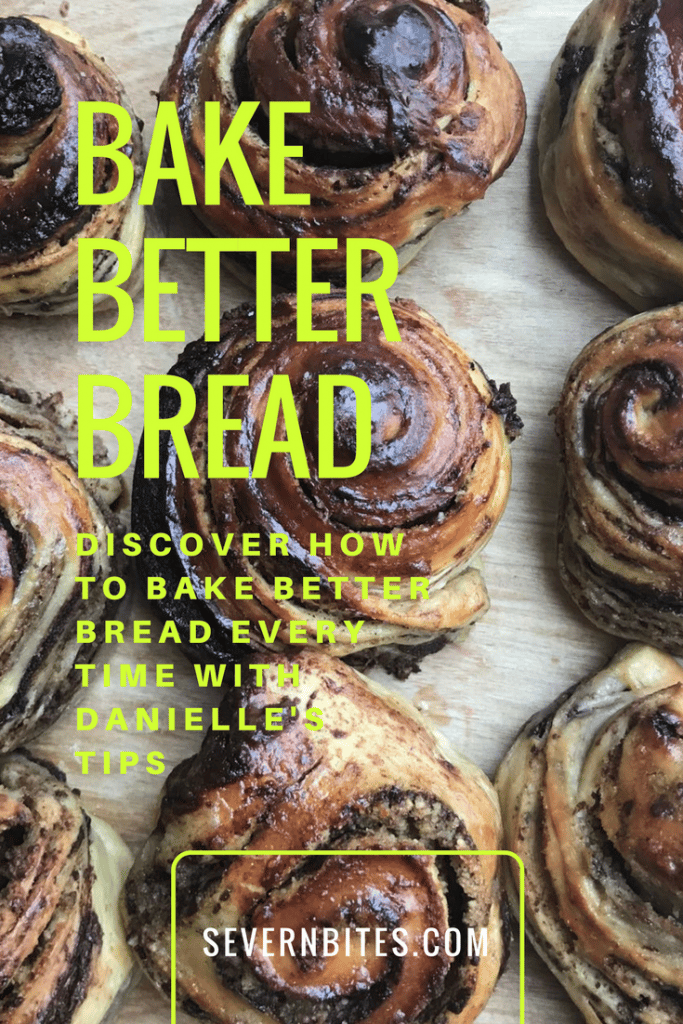Use fresh yeast to improve your bread recipe
Do you think that fresh yeast is difficult to use? What yeast do you use in your bread? Let’s bust some myths.
Baker’s yeast or Saccharomyces cerevisiae is widely used in bread production. Until 1825, all yeast was supplied in liquid form. Nowadays, fresh yeast is mostly commonly pressed and supplied in cubes or blocks. Dried or quick acting yeast is the same strain of yeast supplied in a different form.
I mostly use fresh yeast as my recipes are based on those I was taught in France. It is so easy to use and readily available to purchase and I think gives a superior flavour. It’s also so easy to use!
Fresh yeast is easy to purchase
Most of the large supermarkets make yeasted products in store and some are ready to sell you yeast! Just head for the bakery counter and ask for yeast at the counter. It does vary as to whether they will sell it to you. Expect to pay 50p per 50 gr or less. You simply store it in the fridge in a sealed container. It will last about two weeks.
Alternatively, you can purchase yeast with your online shopping from Ocado or Amazon. Shipton Mill sell a different type of yeast, Bioreal which is organic and lasts up to 1 month.
I’m often asked if you can freeze yeast. You can, but it deteriorates quickly and loses its effectiveness. I wouldn’t advise it. It is far better to use fresh.

Fresh yeast is easy to use
In many recipes the instructions say to pre-mix the fresh yeast with sugar and warm water and leave the mixture until bubble form. There is absolutely no need to do this. Fresh yeast can be mixed in with the flour, water and salt with no preparation and no sugar. If you are hand kneading, rub the yeast into the flour first for easy mixing just as if you were rubbing butter into flour to make pastry.
Fresh yeast is approximately 70% water, dried yeast 7% water. Dried yeast can become more sensitive to high sugar or highly acidic doughs – another reason to use fresh.
Tip: Never put salt on top of fresh yeast, it will destroy the yeast.
How much fresh yeast to use
The amount of fresh yeast you require depends on whether you are making bread or an enriched dough (one that includes eggs and butter). You may find your recipe requires large amounts of fresh yeast which is not necessary!
Simple bread recipes require 1% to 1.5% of the weight of flour. If you’re using 1 kilo of flour, that means you need only 10 to 15 grams of yeast. I use 1.5% if I am making an olive oil dough.

Enriched doughs (ones with butter, eggs and or sugar) need 3% to 4% of the weight of flour. If you’re using 1 kilo of flour add 30 to 40 grams of yeast.
Using too much yeast can lead to a bitter flavour due too much amino acid being released.
Converting dried yeast quantities to fresh
If your recipe uses dried yeast and you’d like to start using fresh, Doves Farm have a handy conversion table. However, I’d suggest you take the weight of flour in your recipe and work out how much you need by percentage as mentioned above. eg 500 grams x .01 = 5 grams. It should be half of the fresh yeast noted.
The role of yeast in the breadmaking process – the tech-y bit
The yeast breaks down the starch in the flour to form carbon dioxide and alcohol (ethanol). The carbon dioxide forms small air bubbles, which makes the dough ferment and become airy. The small amount of alcohol formed in the dough disappears during baking.

Find out more
Why not join one of my classes? There are plenty to choose from, or you can tailor one to suit.
Here are few more bread topics you might enjoy reading:
Bake Better Bread: Baker’s Percentages
Bake Better Bread: Pre ferment – Pâte fermentée
Bake Better Bread: Using heat and steam


I agree I wouldn’t freeze mine. However, I do keep fresh yeast in a sealed plastic box very successfully.
I tried freezing fresh yeast and it turned out liquid when defrosted – so useless really. I find my fresh yeast keeps longest not in plastic (makes it sweat). I keep mine wrapped in paper towel inside a special paper bag well closed off to the air in fridge and it keeps longer tan 2 weeks. Definitely not in plastic unless you intend to use it within a couple of days. It starts to grow a white mold. I’ve been making bread and associated product for more than 50 years.
Lucky you! It is possible to freeze yeast although it isn’t as ‘powerful’ when you defrost it, and it will be liquid. I’d try freezing even a little to see if it works for you!
Einkorn is a lovely flour. What recipe do you currently use? I’d suggest using 1.5% of flour weight in fresh yeast.
This article will help.
I would definitely autolyse your bread first then knead gently, and fold it a few times whilst proving.
Do let me know how it goes and if I can help further.
I just scored a pound of fresh yeast and hope to use it up over the next 2 weeks, although that seems crazy impossible! My question is I only use Einkorn flour. Any suggestions, recipes using fresh yeast and Einkorn flour? Many thanks!
Thank you Sue. Your kind comment means such a lot to me! I am so pleased it worked for you. Do post a picture of your bread. I am on Twitter and Instagram.
Thank you Danielle. Your site popped up on an internet search as I nervously set about using fresh yeast for the first time. I’ve been baking my own bread since the 1970s but have always used dried. As the current lockdown surge of home baking seems to have depleted all supplies of dried yeast I had no choice about the switch. I was puzzling overconversion weights (none of the tables seemed to match the amount I needed) , how easy it would be to dissolve in water, how much water as I use spelt flour which always absorbs far more water than wheat. And then I find your wonderfully straightforward blog post with weight ratios of yeast to flour and you tell me I can just rub it into the flour and therefore add water by ‘feel’ as usual. Wonderful! As I write this, my dough is rising beautifully and I’m so confident in the results that I’m going to post this even before the tins go in the oven!
Hi Jessica, Using fresh yeast is easy, just rub it into the bread flour, you don’t need to add water/sugar first. As a general rule, use 1% of the total flour you are using. eg You’d use 5 grams for 500 gr flour. You could use this recipe.
My grocery store ran out of packaged, dry yeast and the grocer suggested that I purchase fresh yeast! I now have it in my possession, but I am having a hard time finding a bread recipe that uses fresh yeast. Every recipe I find uses dry yeast. Do you have a favorite bread recipe that uses fresh yeast? Or can you give advice on how much fresh yeast to replace in a recipe that uses dry yeast? Thank you!
Would love to hear how you get on.
Great, thanks Danielle,
I had to hunt for it but managed to get some. I’ll try the fridge method, I think we’ll easily go through it in two weeks! Thanks again and stay safe.
Glynn
Hello Glynn, So pleased you’ve found some yeast! It will last up to 2 weeks in the fridge if kept well sealed. I put mine in a small plastic container. I was listening to a podcast yesterday from Honey and Co and they actually freeze theirs. It’s not ideal to do that but if you have a lot, worth trying. It will be rather liquid when defrosted.
Hi Danielle,
Thanks for the tips. As a first time user of fresh yeast, it arrived today! What is the best method of storage for longevity?
Kind regards, Glynn
Hello Madeline, That’s a really great question! There’s no difference in the time to prove with either yeast. It’s more to do with the flavour and ease of use.
Hi Danielle,
Thank you for this useful info! Does using fresh yeast as opposed to dry change the time it takes the dough to rise?
All the best,
Madeline
Hi Tessa, Dried yeast has the naturally occurring water mostly extracted. Here’s an article that explains more – it actually suggests that fresh yeast is 82% water.
The article says the following: Fresh yeast is approximately 70% water, dried yeast 7% water.
I think it is a typo… can you give me the percentages? I am very curious 🙂
Kind regards, Tessa